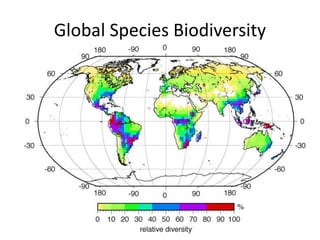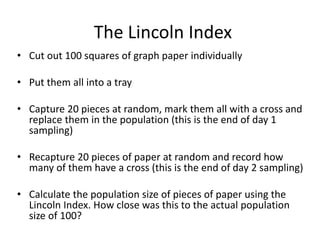Topic 3.1
- 1. Topic 3 Biodiversity and Conservation 3.1 Introduction to Biodiversity
- 2. Biodiversity • Coined by Edward Wilson in the 1980s • It is the number (species richness) and relative abundance of species in a defined area • It can be measured in terms of: – 1. Species diversity – 2. Habitat diversity – 3. Genetic diversity
- 3. 1. Species Diversity • The variety of species per unit area • This is the number of species present and their relative abundance • Areas of high species diversity are usually those undisturbed by humans What is a species?
- 4. 2. Habitat Diversity • The range of different habitats in an ecosystem – Rainforest has a high habitat diversity – Desert has a low habitat diversity What is a habitat?
- 5. 3. Genetic Diversity • The range of genetic material present in a gene pool or population of a species
- 6. The 1992 Rio Earth Summit • The largest environmental meeting ever held • The 2 main objectives were to act on climate change and try to conserve global biodiversity • The participants came up with the following definition of biodiversity: “The variability among living organisms from all sources, including terrestrial, marine and other aquatic ecosystems and the ecological complexes of which they are part; this includes diversity within species, between species and of ecosystems”
- 8. Why is there a Global Pattern? • Biodiversity is highest towards the equator and lowest towards the poles • Highest biodiversity were there are least limiting factors – Fairly high rainfall – Fairly high insolation (sunlight) – Equitable temperature • This results in – High primary production – Different soil types – Long periods of succession and evolution – Larger numbers of species/niches/different habitats (horizontally and vertically) In addition there are biodiversity hotspots such as Feynbos, South Africa
- 9. Questions 1. Why is it important to measure biodiversity? 2. Why is it important to measure biodiversity?
- 10. Measuring Biodiversity • Species richness is simply the number of different species that are counted in a sample area • Biodiversity is a measurement which combines: – The number of different species present – The relative numbers of individuals of each species • Biodiversity can be expressed as Simpson’s Biodiversity Index
- 11. Calculating Population Size Population size = total number of organisms in all quadrats x Area of field number of quadrats thrown Area of one quadrat • Throw 10 quadrats and collect the data. Use it to calculate the population size of daisies. • How close were you to the actual population size?
- 12. Simpson’s Diversity Index Biologists use a more complicated formula called Simpson's Diversity Index which calculates biodiversity rather than simply population size: D = N (N – 1) Σn (n – 1) Where: D = diversity index (simply a number with no units) N = total number of organisms of all species found n = total number of individuals found of the species you are interested in Use the calculation to calculate the diversity index for daisies and clover, by throwing 10 quadrats in total
- 13. Biodiversity • We don’t just have to count the number of individuals. We could also measure: Abundance - estimates plentifulness of a species or target group according to a predefined scale, such as rare, infrequent, abundant, etc. Density - abundance, measured by actual count, per unit area. Counts are averaged when more than one sample is taken. Frequency - the percentage of sample plots in which a species or target group appears. Frequency data are often grouped into classes, such as A = 1- 20%, B = 21-40%, C = 41-60%, D = 61-80%, E = 81-100%. Cover - commonly measured as "Total Cover", which is the percentage of all vegetation covering the ground surface inside the quadrat, or as "Species Cover", which is the percentage of the target species covering the ground surface inside the quadrat. Biomass - the dry weight of the total vegetation or target species inside a quadrat. Sampling consists of clipping the vegetation to ground level, sorting by species if required, oven drying the sorted clippings, and weighing. Figure 3 shows new growth inside a quadrat that had previously been clipped.
- 14. Other Methods to Determine Population Size and/or Biodiversity • Mark-recapture • Animals cannot be counted in the same way as plants (they move around) • The Lincoln Index is used to estimate population size (note: not biodiversity)
- 15. The Lincoln Index N = n1 x n2 m Where: N = total population size of animal of interest in the study site n1 = number of animals captured on the first day n2 = number of animals captured on the second day m = number of marked animals in the sample recaptured on the second day • Can you see a potential problem that might lead to inaccurate results? • What kind of ethical considerations must you take into account during mark-recapture sampling?
- 16. The Lincoln Index • Cut out 100 squares of graph paper individually • Put them all into a tray • Capture 20 pieces at random, mark them all with a cross and replace them in the population (this is the end of day 1 sampling) • Recapture 20 pieces of paper at random and record how many of them have a cross (this is the end of day 2 sampling) • Calculate the population size of pieces of paper using the Lincoln Index. How close was this to the actual population size of 100?
- 17. Other Methods to Determine Population Size and/or Biodiversity • Chemical Fogging – http://edroness.blogspot.mx/2013/10/measuring-biodiversity.html – This is a method created by Dr. Terry Erwin to measure insect biodiversity in the rainforest canopy – It involves using an insecticide to kill all the insects in a section of canopy and collecting the bodies as they fall – Can this be justified ethically?

















